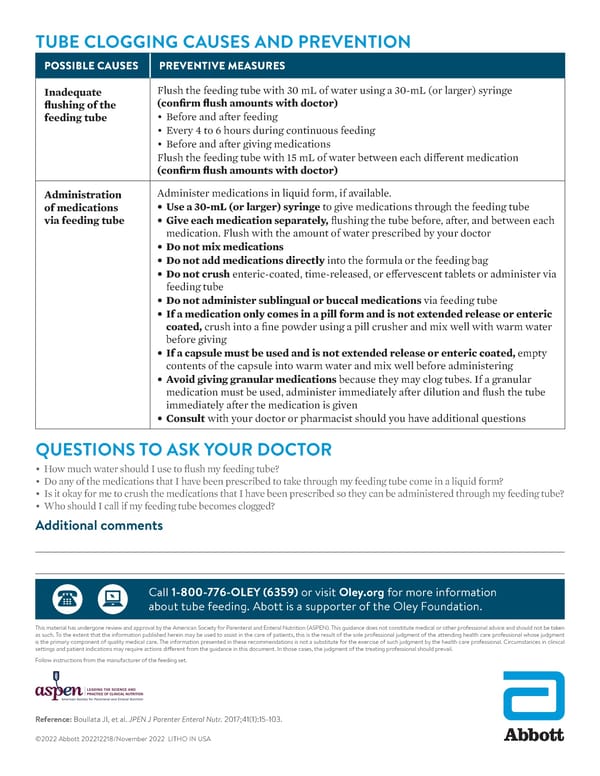TUBE CLOGGING CAUSES AND PREVENTION POSSIBLE CAUSES PREVENTIVE MEASURES Inadequate Flush the feeding tube with 30 mL of water using a 30-mL (or larger) syringe flushing of the (confirm flush amounts with doctor) feeding tube • Before and after feeding • Every 4 to 6 hours during continuous feeding • Before and after giving medications Flush the feeding tube with 15 mL of water between each different medication (confirm flush amounts with doctor) Administration Administer medications in liquid form, if available. of medications • Use a 30-mL (or larger) syringe to give medications through the feeding tube via feeding tube • Give each medication separately, flushing the tube before, after, and between each medication. Flush with the amount of water prescribed by your doctor • Do not mix medications • Do not add medications directly into the formula or the feeding bag • Do not crush enteric-coated, time-released, or effervescent tablets or administer via feeding tube • Do not administer sublingual or buccal medications via feeding tube • If a medication only comes in a pill form and is not extended release or enteric coated, crush into a fine powder using a pill crusher and mix well with warm water before giving • If a capsule must be used and is not extended release or enteric coated, empty contents of the capsule into warm water and mix well before administering • Avoid giving granular medications because they may clog tubes. If a granular medication must be used, administer immediately after dilution and flush the tube immediately after the medication is given • Consult with your doctor or pharmacist should you have additional questions QUESTIONS TO ASK YOUR DOCTOR • How much water should I use to flush my feeding tube? • Do any of the medications that I have been prescribed to take through my feeding tube come in a liquid form? • Is it okay for me to crush the medications that I have been prescribed so they can be administered through my feeding tube? • Who should I call if my feeding tube becomes clogged? Additional comments Call 1-800-776-OLEY (6359) or visit Oley.org for more information about tube feeding. Abott is a supporter of the Oley Foundation. This material has undergone review and approval by the American Society for Parenteral and Enteral Nutrition (ASPEN). This guidance does not constitute medical or other professional advice and should not be taken as such. To the extent that the information published herein may be used to assist in the care of patients, this is the result of the sole professional judgment of the attending health care professional whose judgment is the primary component of quality medical care. The information presented in these recommendations is not a substitute for the exercise of such judgment by the health care professional. Circumstances in clinical settings and patient indications may require actions different from the guidance in this document. In those cases, the judgment of the treating professional should prevail. Follow instructions from the manufacturer of the feeding set. Reference: Boullata JI, et al. JPEN J Parenter Enteral Nutr. 2017;41(1):15-103. ©2022 Abbott 202212218/November 2022 LITHO IN USA
 Helping to Prevent and Treat Tube Clogs and Blockages Page 1
Helping to Prevent and Treat Tube Clogs and Blockages Page 1 